The internal organs of the female consists of the uterus, vagina, fallopian tubes, and the ovaries (see figures 1-1 and 1-2).
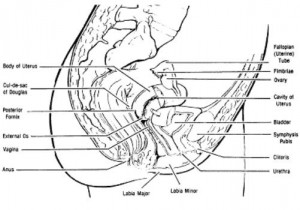
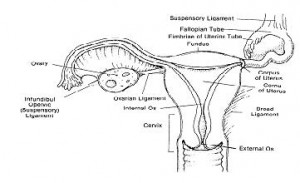
a. Uterus.
The uterus is a hollow organ about the size and shape of a pear. It serves two important functions: it is the organ of menstruation and during pregnancy it receives the fertilized ovum, retains and nourishes it until it expels the fetus during labor.
(1) Location. The uterus is located between the urinary bladder and the rectum. It is suspended in the pelvis by broad ligaments.
(2) Divisions of the uterus. The uterus consists of the body or corpus, fundus, cervix, and the isthmus. The major portion of the uterus is called the body or corpus. The fundus is the superior, rounded region above the entrance of the fallopian tubes. The cervix is the narrow, inferior outlet that protrudes into the vagina. The isthmus is the slightly constricted portion that joins the corpus to the cervix.
(3) Walls of the uterus (see figure 1-3). The walls are thick and are composed of three layers: the endometrium, the myometrium, and the perimetrium. The endometrium is the inner layer or mucosa. A fertilized egg burrows into the endometrium (implantation) and resides there for the rest of its development.
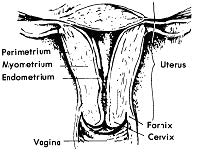
When the female is not pregnant, the endometrial lining sloughs off about every 28 days in response to changes in levels of hormones in the blood. This process is called menses. The myometrium is the smooth muscle component of the wall. These smooth muscle fibers are arranged. In longitudinal, circular, and spiral patterns, and are interlaced with connective tissues. During the monthly female cycles and during pregnancy, these layers undergo extensive changes. The perimetrium is a strong, serous membrane that coats the entire uterine corpus except the lower one fourth and anterior surface where the bladder is attached.
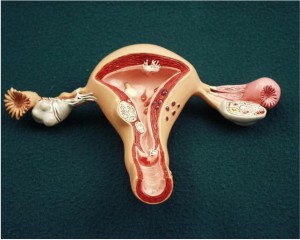
b. Vagina.
(1) Location. The vagina is the thin in walled muscular tube about 6 inches long leading from the uterus to the external genitalia. It is located between the bladder and the rectum.
(2) Function. The vagina provides the passageway for childbirth and menstrual flow; it receives the penis and semen during sexual intercourse.
c. Fallopian Tubes (Two).
(1) Location. Each tube is about 4 inches long and extends medially from each ovary to empty into the superior region of the uterus.
(2) Function. The fallopian tubes transport ovum from the ovaries to the uterus. There is no contact of fallopian tubes with the ovaries.
(3) Description. The distal end of each fallopian tube is expanded and has finger-like projections called fimbriae, which partially surround each ovary. When an oocyte is expelled from the ovary, fimbriae create fluid currents that act to carry the oocyte into the fallopian tube. Oocyte is carried toward the uterus by combination of tube peristalsis and cilia, which propel the oocyte forward. The most desirable place for fertilization is the fallopian tube.
d. Ovaries (2) (see figure 1-4).
(1) Functions. The ovaries are for oogenesis-the production of eggs (female sex cells) and for hormone production (estrogen and progesterone).
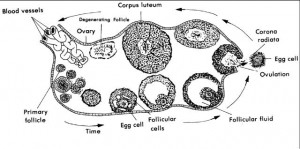
(2) Location and gross anatomy. The ovaries are about the size and shape of almonds. They lie against the lateral walls of the pelvis, one on each side. They are enclosed and held in place by the broad ligament. There are compact like tissues on the ovaries, which are called ovarian follicles. The follicles are tiny sac-like structures that consist of an immature egg surrounded by one or more layers of follicle cells. As the developing egg begins to ripen or mature, follicle enlarges and develops a fluid filled central region. When the egg is matured, it is called a graafian follicle, and is ready to be ejected from the ovary.
(3) Process of egg production–oogenesis (see figure 1-5).
(a) The total supply of eggs that a female can release has been determined by the time she is born. The eggs are referred to as “oogonia” in the developing fetus. At the time the female is born, oogonia have divided into primary oocytes, which contain 46 chromosomes and are surrounded by a layer of follicle cells.
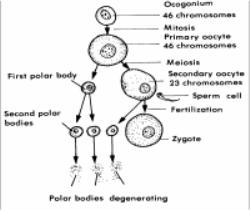
(b) Primary oocytes remain in the state of suspended animation through childhood until the female reaches puberty (ages 10 to 14 years). At puberty, the anterior pituitary gland secretes follicle-stimulating hormone (FSH), which stimulates a small number of primary follicles to mature each month.
(c) As a primary oocyte begins dividing, two different cells are produced, each containing 23 unpaired chromosomes. One of the cells is called a secondary oocyte and the other is called the first polar body. The secondary oocyte is the larger cell and is capable of being fertilized. The first polar body is very small, is nonfunctional, and incapable of being fertilized.
(d) By the time follicles have matured to the graafian follicle stage, they contain secondary oocytes and can be seen bulging from the surface of the ovary. Follicle development to this stage takes about 14 days. Ovulation (ejection of the mature egg from the ovary) occurs at this 14-day point in response to the luteinizing hormone (LH), which is released by the anterior pituitary gland.
(e) The follicle at the proper stage of maturity when the LH is secreted will rupture and release its oocyte into the peritoneal cavity. The motion of the fimbriae draws the oocyte into the fallopian tube. The luteinizing hormone also causes the ruptured follicle to change into a granular structure called corpus luteum, which secretes estrogen and progesterone.
(f) If the secondary oocyte is penetrated by a sperm, a secondary division occurs that produces another polar body and an ovum, which combines its 23 chromosomes with those of the sperm to form the fertilized egg, which contains 46 chromosomes.
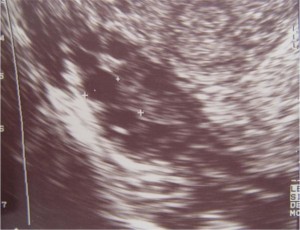
(4) Process of hormone production by the ovaries.
(a) Estrogen is produced by the follicle cells, which are responsible secondary sex characteristics and for the maintenance of these traits. These secondary sex characteristics include the enlargement of fallopian tubes, uterus, vagina, and external genitals; breast development; increased deposits of fat in hips and breasts; widening of the pelvis; and onset of menses or menstrual cycle.
(b) Progesterone is produced by the corpus luteum in presence of in the blood. It works with estrogen to produce a normal menstrual cycle. Progesterone is important during pregnancy and in preparing the breasts for milk production.
